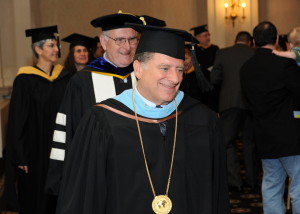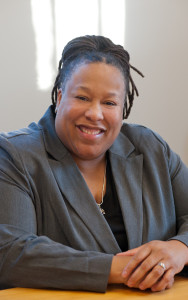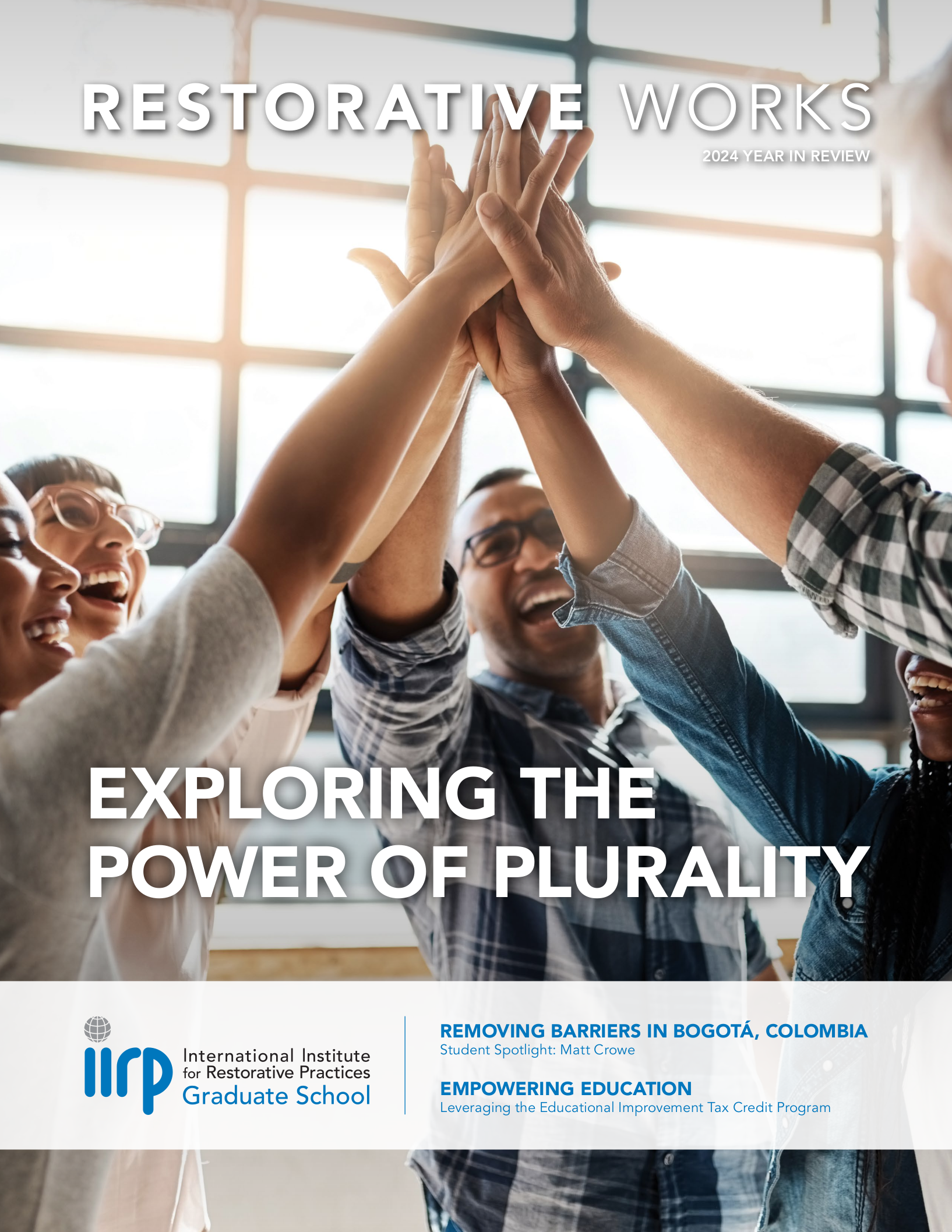News & Announcements
- Details
- Written by Laura Mirsky
 IIRP President and Founder Ted WachtelTed Wachtel, President and Founder of the International Institute for Restorative Practices (IIRP), has announced his intention to retire from the presidency in June 2015, at the end of the IIRP Graduate School’s academic year. Ted will continue to pursue the sort of visionary restorative projects that have been his hallmark, which the IIRP will support and report on.
IIRP President and Founder Ted WachtelTed Wachtel, President and Founder of the International Institute for Restorative Practices (IIRP), has announced his intention to retire from the presidency in June 2015, at the end of the IIRP Graduate School’s academic year. Ted will continue to pursue the sort of visionary restorative projects that have been his hallmark, which the IIRP will support and report on.
Passionate about the power of restorative practices — giving people a voice and a choice in things that matter to them — to build social capital and improve civil society, Ted envisioned and founded the IIRP and shepherded its expansion across the globe — in education, justice, social services and other fields. Ted was also the driving force behind the establishment of the IIRP as an accredited graduate school and the recognition of restorative practices as a field worthy of study at the graduate level.
- Details
- Written by Joshua Wachtel
 Superintendent of Pittsburgh Public Schools, Dr. Linda S. Lane, welcomes families back to school.One in five students was suspended from Pittsburgh Public Schools last year. One school suspended 79 percent of its students. What’s more, many students say they feel they have to fight to defend themselves in school.
Superintendent of Pittsburgh Public Schools, Dr. Linda S. Lane, welcomes families back to school.One in five students was suspended from Pittsburgh Public Schools last year. One school suspended 79 percent of its students. What’s more, many students say they feel they have to fight to defend themselves in school.
To make their schools safer, the leadership of Pittsburgh Public Schools, like those in several other school districts across the country, is embarking on a watershed project to implement restorative practices — a proven alternative to ineffective and harmful zero tolerance policies.
- Details
- Written by Joshua Wachtel
Chicago Public Schools (CPS), the third largest district in the U.S., is collaborating with more than two dozen Chicago-based organizations to end the school-to-prison pipeline by implementing restorative practices.
 Student explains the use of a talking piece during a circle at Umoja's 2013 Community Builders "Safe Spaces" summer internship.Ten years of grassroots organizing and practice has raised community awareness and helped demonstrate the effectiveness of restorative justice. Efforts have also led to policy changes, such as the revision of the CPS Student Code of Conduct and the city’s Juvenile Justice Code, which explicitly include restorative justice. Balanced and Restorative Justice, according to the CPS Student Code of Conduct include “ways of thinking about and responding to conflicts and problems by involving all participants to identify what happened, describe how it affected everyone, and find solutions to make things right.”
Student explains the use of a talking piece during a circle at Umoja's 2013 Community Builders "Safe Spaces" summer internship.Ten years of grassroots organizing and practice has raised community awareness and helped demonstrate the effectiveness of restorative justice. Efforts have also led to policy changes, such as the revision of the CPS Student Code of Conduct and the city’s Juvenile Justice Code, which explicitly include restorative justice. Balanced and Restorative Justice, according to the CPS Student Code of Conduct include “ways of thinking about and responding to conflicts and problems by involving all participants to identify what happened, describe how it affected everyone, and find solutions to make things right.”
- Details
- Written by Joshua Wachtel
Bullying is a great area of concern, especially in schools. In this video, IIRP Instructor Lee Rush talks about the way restorative practices dovetails with bullying prevention.
- Details
- Written by Joshua Wachtel
 Dr. Stacey Miller, Director of Residential Life at the University of Vermont (UVM) since 2003, receives a lot of calls from people across the country inquiring about how they can bring restorative practices to their campuses. “I can feel the momentum swinging. It’s going to tip,” she says.
Dr. Stacey Miller, Director of Residential Life at the University of Vermont (UVM) since 2003, receives a lot of calls from people across the country inquiring about how they can bring restorative practices to their campuses. “I can feel the momentum swinging. It’s going to tip,” she says.
Miller was elected this month to serve on the IIRP Board of Trustees. Her enthusiasm for restorative practices has made her an effective leader of implementation efforts in her department and across campus. Now she will bring that leadership to the Board of the IIRP. “I am honored to have even been asked,” Miller says. “I am really humbled by the opportunity to participate and be a Board member.”
- Details
- Written by Joshua Wachtel
Featured
"A Philly first: No schools on Pennsylvania's 'persistently dangerous' list." Restorative practices are credited in the article for helping schools make this progress.
The NEA, the nation's largest teacher's union, hosts a talk, "School to Prison Pipeline - Restorative Strategies" with Kevin Gilbert, a member of the NEA's Executive Committee, Thursday, October 23, 2014, from 7-8 p.m. EDT.
The 6th International Juvenile Justice Observatory (IJJO) International Conference in Brussels, "Making deprivation of children's liberty a last resort: Towards evidence-based policies on alternatives," takes place in Belgium on December 3-4, 2014.
- Details
- Written by IIRP Staff
An invitation to students, parents, teachers and community organizations
Introduction to Restorative Practices – An Educational Workshop
Three dates: Sat., Oct. 18 or Sat., Nov. 8 or Sat., Dec. 20 (Each day runs 8:30 am–3:30 pm.)
Location: School District of Philadelphia Education Center, 440 N. Broad St., Philadelphia, PA 19130
- Details
- Written by Laura Mirsky
 The restorative environment at Community Service Foundation and Buxmont Academy (CSF Buxmont) schools for at-risk youth enhances the effectiveness of the Aggression Replacement Training® cognitive-behavioral intervention program.
The restorative environment at Community Service Foundation and Buxmont Academy (CSF Buxmont) schools for at-risk youth enhances the effectiveness of the Aggression Replacement Training® cognitive-behavioral intervention program.
This is why the Aggression Replacement Training program is more effective with youth at CSF schools than with other Pennsylvania youth, theorizes CSF Buxmont Executive Director, Dr. Craig Adamson. “At CSF Buxmont schools, students are surrounded by a supportive treatment model that includes counseling and peer support, which creates many opportunities — all day long — to enrich what students are learning in the Aggression Replacement Training program,” says Dr. Adamson.
- Details
- Written by Laura Mirsky
This piece, by Laura Mirsky, the IIRP's assistant director for communications, was published originally by Educational Leadership Magazine, Summer 2014, Association of Supervision and Curriculum Development (ASCD). Download a pdf of the article from Educational Leadership.
When schools use restorative practices to build relationships and community, students’ attitudes change for the better.
 Students at Warren G. Harding Middle School in Philadelphia use a “talking piece” to indicate whose turn it is to speak during a restorative circle facilitated by teacher Denise James. (Photo by Danielle Marie Phil.)In April 2014, students at Warren G. Harding Middle School, in Philadelphia, Pennsylvania, had just finished a week of state testing, which they had found very stressful. Like all Harding’s teachers, 7th grade language arts teacher Denise James had her students sit in a circle and discuss the purpose of the tests and how they felt about having to take them.
Students at Warren G. Harding Middle School in Philadelphia use a “talking piece” to indicate whose turn it is to speak during a restorative circle facilitated by teacher Denise James. (Photo by Danielle Marie Phil.)In April 2014, students at Warren G. Harding Middle School, in Philadelphia, Pennsylvania, had just finished a week of state testing, which they had found very stressful. Like all Harding’s teachers, 7th grade language arts teacher Denise James had her students sit in a circle and discuss the purpose of the tests and how they felt about having to take them.
- Details
- Written by Joshua Wachtel
Higher Education
Higher-ed student conduct professionals are encouraged to attend the Association for Student Conduct Administration (ASCA) webinar on Restorative Justice in higher education, with the IIRP's Steve Korr, Michigan State University's Rick Shafer and Washington University in St. Louis's Molly Pierson.

Restorative Works Year in Review 2024 (PDF)
All our donors are acknowledged annually in Restorative Works.

